 W
WTeaware is a broad international spectrum of equipment used in the brewing and consumption of tea. Many components make up that spectrum, and vary greatly based upon the type of tea being prepared, and the cultural setting in which it is being prepared. This is often referred to as the tea ceremony, and holds much significance in many cultures, particularly in northwestern Europe and in eastern Asia. A complete, cohesive collection of tea ware makes up a tea set.
 W
WArmudu or Armudu stəkan, sometimes called Boğmalı is a kind of drinking glass used for black tea in Azerbaijan. It is similar to the Turkish traditional tea glass called ince belli bardak.
 W
WA caddy spoon is a spoon used for measuring out tea in the form of dried tea leaves. Traditionally made of silver, they were in common use in the 19th century, when tea was a more expensive commodity. Tea was sometimes stored in elaborate boxes or containers called tea caddies, and these spoons were made to be used with such containers.
 W
WA chawan is a bowl used for preparing and drinking tea. Many types of chawan are used in East Asian tea ceremonies. The choice of their use depends upon many considerations.
 W
WA creamer is a small pitcher or jug designed for holding cream or milk to be served with tea or coffee in the Western tradition. Creamers can be earthenware or porcelain, but also made of silver or other metals; a creamer is an obligatory part of a coffee or tea set, whether in silver or ceramics.
 W
WA cup is an close-top container used to hold or cold liquids for pouring or drinking; while mainly used for drinking, it also can be used to store solids for pouring. Cups may be made of glass, metal, china, clay, wood, stone, polystyrene, plastic, aluminium or other materials, and are usually fixed with a stem, handles, or other adornments. Cups are used for quenching thirst across a wide range of cultures and social classes, and different styles of cups may be used for different liquids or in different situations. Cups of different styles may be used for different types of liquids or other foodstuffs, in different situations ,or for decoration.
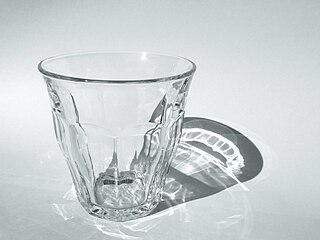 W
WThe Duralex Picardie is classic design of toughened glass tumbler found in cafes, schools and homes across France and in many places worldwide. It is manufactured by Duralex in La Chapelle-Saint-Mesmin in Loiret. The design has been produced in a range of sizes but they typically share markings on their bottoms with "MADE IN FRANCE" surrounding in circular design the name "DURALEX". According to Agence France-Presse, the glasses are "considered icons of modern design" and are sold in the Museum of Modern Art.
 W
WA faceted glass or granyonyi stakan is a type of drinkware made from especially hard and thick glass and having a faceted form. It is a very widespread form of drinking glass in Russia and the former Soviet Union.
 W
WFlagstaff House, built in 1846, is the oldest example of Western-style architecture remaining in Hong Kong. It is located at 10 Cotton Tree Drive, Central – within the Hong Kong Park.
 W
WA gaiwan or zhong (盅) is a Chinese lidded bowl without a handle, used for the infusion of tea leaves and the consumption of tea. It was invented during the Ming dynasty. It consists of a bowl, a lid, and a saucer.
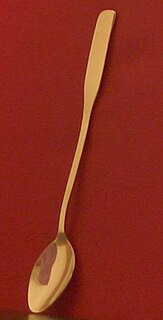 W
WAn iced tea spoon, also called a soda spoon or a latte spoon, is a thin spoon with a very long handle. It is used primarily in the United States, for stirring sugar or other sweeteners into iced tea, which is traditionally served in a tall glass. This is why the spoon has a very long handle.
 W
WA kettle, sometimes called a tea kettle or teakettle, is a type of pot specialized for boiling water, commonly with a lid, spout, and handle, or a small electric kitchen appliance of similar shape that functions in a self-contained manner. Kettles can be heated either by placing on a stove, or by their own internal electric heating element in the appliance versions. As indicated by its name, the kettle was and is often used as teaware to brew tea or prepare a tisane. Some very modern versions do more than just boil water, and also make the tea and keep it warm.
 W
WKujiejun is a type of bamboo stove and is also a special term for "tea stove".
 W
WA mug is a type of cup typically used for drinking hot drinks, such as coffee, hot chocolate, or tea. Mugs usually have handles and hold a larger amount of fluid than other types of cup. Typically, a mug holds approximately 240–350 ml of liquid. A mug is a less formal style of drink container and is not usually used in formal place settings, where a teacup or coffee cup is preferred. Shaving mugs are used to assist in wet shaving.
 W
WA piyāla, also called piola, piyola, piala or chini is a small ceramic bowl used throughout Central Asia for drinking tea. It is similar to the East Asian chawan. Piyālas may be used for other beverages too, such as kymyz, though traditionally a full-size bowl is used for cold and hot beverages.
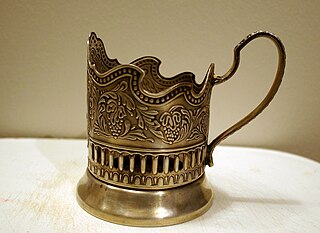 W
WThe podstakannik, or tea glass holder, is a holder with a handle, most commonly made of metal that holds a drinking glass (stakan). Their primary purpose is to be able to hold a very hot glass of tea, which is usually consumed right after it is brewed. The stability of the glass on the table is also significantly improved. It is a traditional way of serving and drinking tea in Russia, Ukraine, Belarus, and other Slavic states.
 W
WA samovar is a metal container traditionally used to heat and boil water. Although originating in Russia, the samovar is well known outside of Russia and has spread through Russian culture to Eastern Europe, South-Eastern Europe, Iran, Afghanistan, Kashmir, the Middle East, Azerbaijan and is also known in some parts of Central Europe. Since the heated water is typically used to make tea, many samovars have a ring-shaped attachment around the chimney to hold and heat a teapot filled with tea concentrate. Though traditionally heated with coal or kindling, many newer samovars use electricity to heat water in a manner similar to an electric water boiler. Antique samovars are often prized for their beautiful workmanship.
 W
WA saucer is a type of small dishware. While in the Middle Ages a saucer was used for serving condiments and sauces, currently the term is used to denote a small plate or shallow bowl that supports a cup – usually one used to serve coffee or tea. The center of the saucer often contains a depression or raised ring sized to fit a matching cup; this was only introduced in the mid 18th century. The saucer is useful for protecting surfaces from possible damage due to the heat of a cup, and to catch overflow, splashes, and drips from the cup, thus protecting both table linen and the user sitting in a free-standing chair who holds both cup and saucer. The saucer also provides a convenient place for a wet spoon, as might be used to stir the drink in the cup in order to mix sweeteners or creamers into tea or coffee.
 W
WSbitenshchik was a sbiten vendor and was spread in Old Rus' regions of Novgorod, Kiev, Moscow and other Rus' cities and regions. The vendor was used for the preparation and serving of the traditional honey-based beverage sbiten in Rus' that has been around since the 12th century. The vendor was normally used in winter as the drink was prepared in wintertime. Sbitenshchik was used in Rus' principalities often on the streets to cook the drink and to sell it to the freezing people. The vendor is documented in the Russian Lubok prints. Sbitenshchik became 1783 the main theme of the popular comic opera The Sbiten Vendor by Yakov Knyazhnin with music by Czech composer Antoine Bullant.
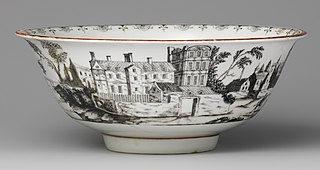 W
WIn Europe, a slop bowl, slop basin or waste bowl is one of the components of a traditional tea set. It was used to empty the cold tea and dregs in tea cups before refilling with hot tea, as there were often tea leaves in the bottom of the cups.
 W
WA teaspoon (tsp.) is an item of cutlery. It is a small spoon that can be used to stir a cup of tea or coffee, or as a tool for measuring volume. The size of teaspoons ranges from about 2.5 to 7.3 mL. For cooking purposes and, more importantly, for dosing of medicine, a teaspoonful is defined as 5 mL, and standard measuring spoons are used.
 W
WA sugar bowl is a small bowl designed for holding sugar or sugar cubes, to be served with tea or coffee in the Western tradition, that is an integral part of a tea set.
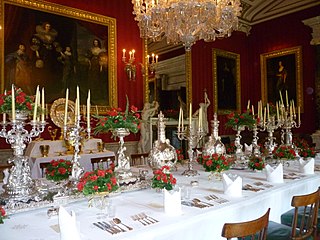 W
WTableware is any dish or dishware used for setting a table, serving food, and dining. It includes cutlery, glassware, serving dishes, and other items for practical as well as decorative purposes. The quality, nature, variety and number of objects varies according to culture, religion, number of diners, cuisine and occasion. For example, Middle Eastern, Indian or Polynesian food culture and cuisine sometimes limits tableware to serving dishes, using bread or leaves as individual plates. Special occasions are usually reflected in higher quality tableware.
 W
WA tea caddy is a box, jar, canister, or other receptacle used to store tea. When first introduced to Europe from Asia, tea was extremely expensive, and kept under lock and key. The containers used were often expensive and decorative, to fit in with the rest of a drawing-room or other reception room. Hot water was carried up from the kitchen, and the tea made by the mistress of the house, or under her supervision.
 W
WA tea cosy or tea warmer is a cover for a teapot, traditionally made of cloth. It insulates a teapot, keeping the contents warm. Their use predates the invention of vacuum flasks as a means of keeping hot liquids hot. Tea cosies may have padded inserts that can be removed and washed.
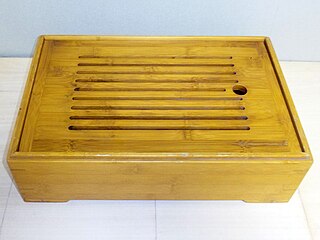 W
WA tea draining tray, tea tray, Gongfu tea tray, or tea sea is an integral piece of equipment for the Gongfu tea ceremony.
 W
WA tea pet or tea lover's pet, also known as tea friend, is a small clay figure which is kept by some tea drinkers for good luck. They are usually made of "zisha" or Yixing clay, from the region near Yixing in Jiangsu province, China. Just like Yixing teapots made of the same clay, tea pets are unglazed, and are mostly monochromatic with a rough surface.
 W
WA tea set or tea service is a collection of matching teaware and related utensils used in the preparation and serving of tea. The traditional components of a tea set may vary between societies and cultures.
 W
WA tea stove is a specialized type of Chinese brazier or stove designed to boil water.
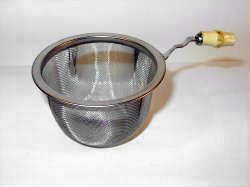 W
WA tea strainer is a type of strainer that is placed over or in a teacup to catch loose tea leaves.
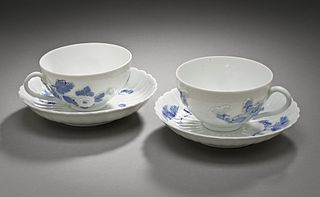 W
WA teacup is a cup for drinking tea. It may be with a handle, generally a small one that may be grasped with the thumb and one or two fingers. It is typically made of a ceramic material. It is usually part of a set, composed of a cup and a matching saucer or a trio that includes a small cake or sandwich plate. These in turn may be part of a tea set in combination with a teapot, cream jug, covered sugar bowl and slop bowl en suite. Teacups are often wider and shorter than coffee cups. Cups for morning tea are conventionally larger than cups for afternoon tea.
 W
WA teasmade is a machine for making tea automatically, which was once common in the United Kingdom and some British Commonwealth countries. Teasmades generally include an analogue alarm clock and are designed to be used at the bedside, to ensure tea is ready first thing in the morning. Although crude versions existed in Victorian times, they only became practical with the availability of electric versions in the 1930s. They reached their peak in popularity in the 1960s and 1970s. Since then their use has declined, but they are now enjoying a revival, partly as a retro novelty item.
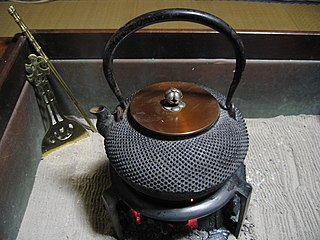 W
WTetsubin (鉄瓶) are Japanese cast-iron kettles with a pouring spout, a lid, and a handle crossing over the top, used for boiling and pouring hot water for drinking purposes, such as for making tea.
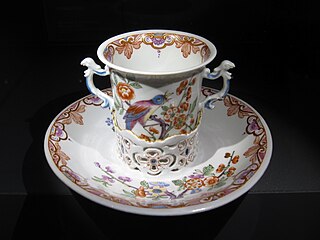 W
WTrembleuse or Tasse Trembleuse also Gobelet et soucoupe enfoncé, is a drinking cup and saucer with the saucer given a raised holding area in which the cup sits more securely than in the normal style. Often the well in the saucer is in openwork, as in the Vienna example illustrated.
 W
WAn urn is a vase, often with a cover, with a typically narrowed neck above a rounded body and a footed pedestal. Describing a vessel as an "urn", as opposed to a vase or other terms, generally reflects its use rather than any particular shape or origin. The term is especially often used for funerary urns, vessels used in burials, either to hold the cremated ashes or as grave goods, but is used in many other contexts; in catering large vessels for serving tea or coffee are often called "tea-urns", even when they are metal cylinders of purely functional design. Large sculpted vases are often called urns, whether placed outdoors, in gardens or as architectural ornaments on buildings, or kept inside.
 W
WA Windermere kettle is a form of steam-operated tea urn or samovar installed on some steam launches. They are a metal vessel containing a few pints of water. Inside the vessel is a steam heating coil. When hot or boiling water is required, a valve is opened and steam from the boat's propulsion boiler is passed through the coil, heating the water. Their exhaust is either overboard or up the funnel, as convenient. Windermere kettles are rapid boilers and can heat enough water to make a pot of tea in only a few seconds.
 W
WA yunomi is a tall form of a Japanese teacup, typically made from a ceramic material and having no handle.